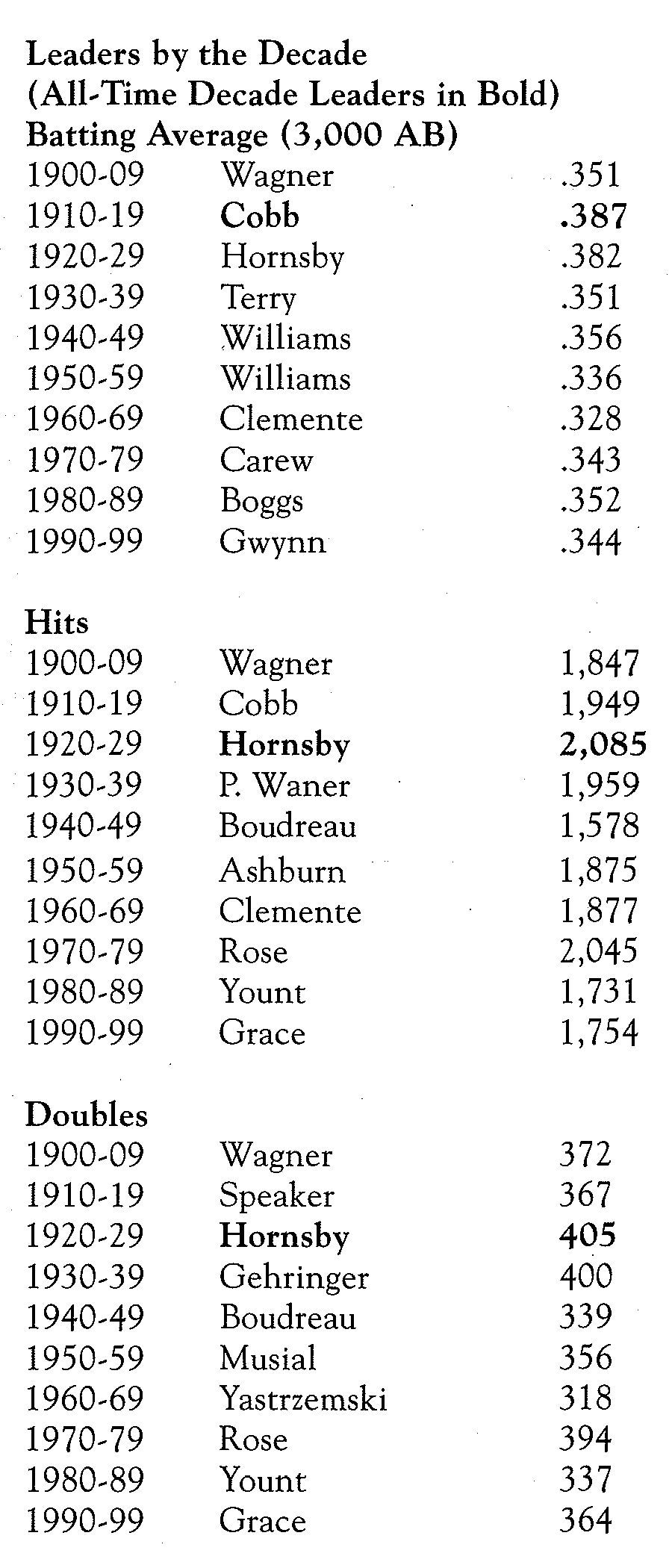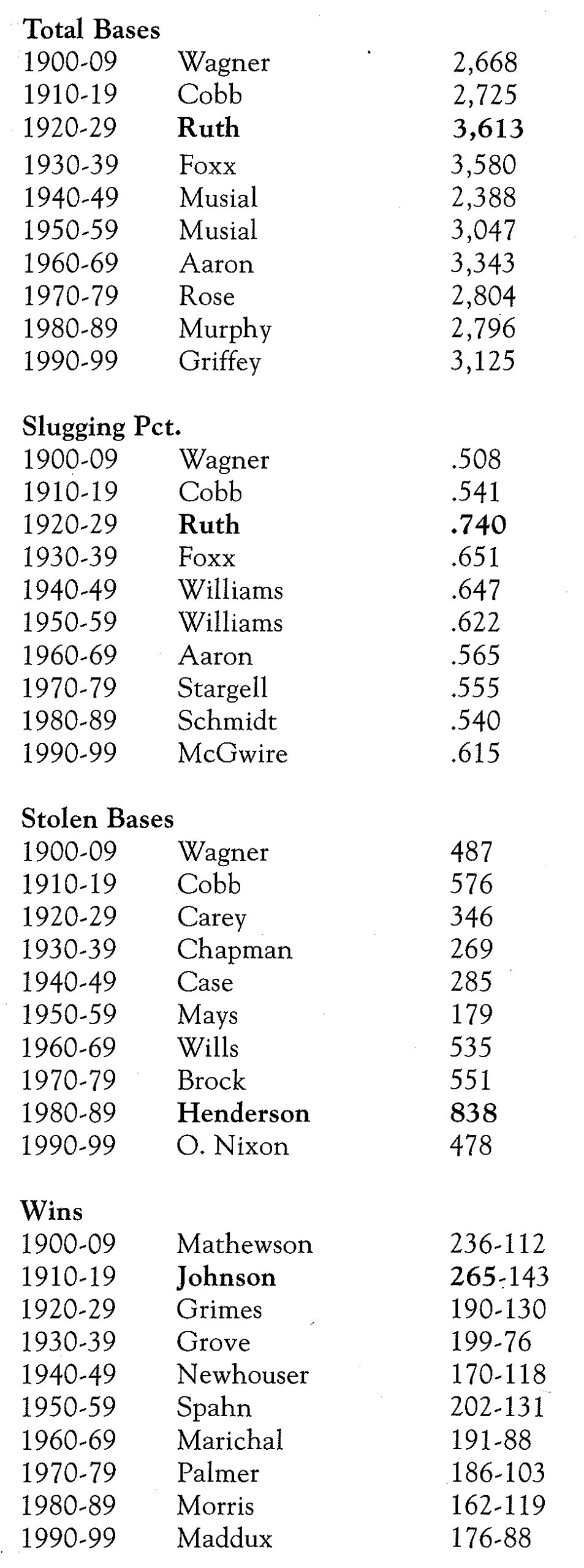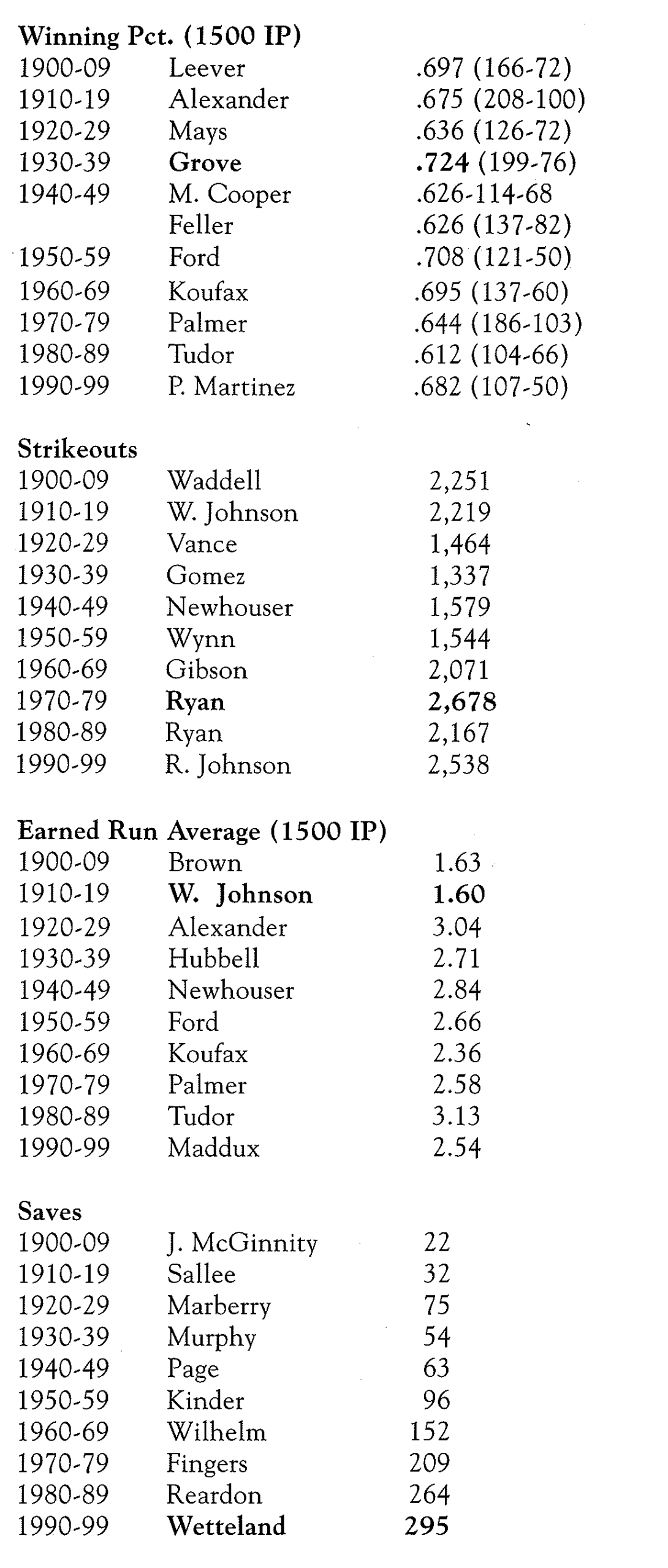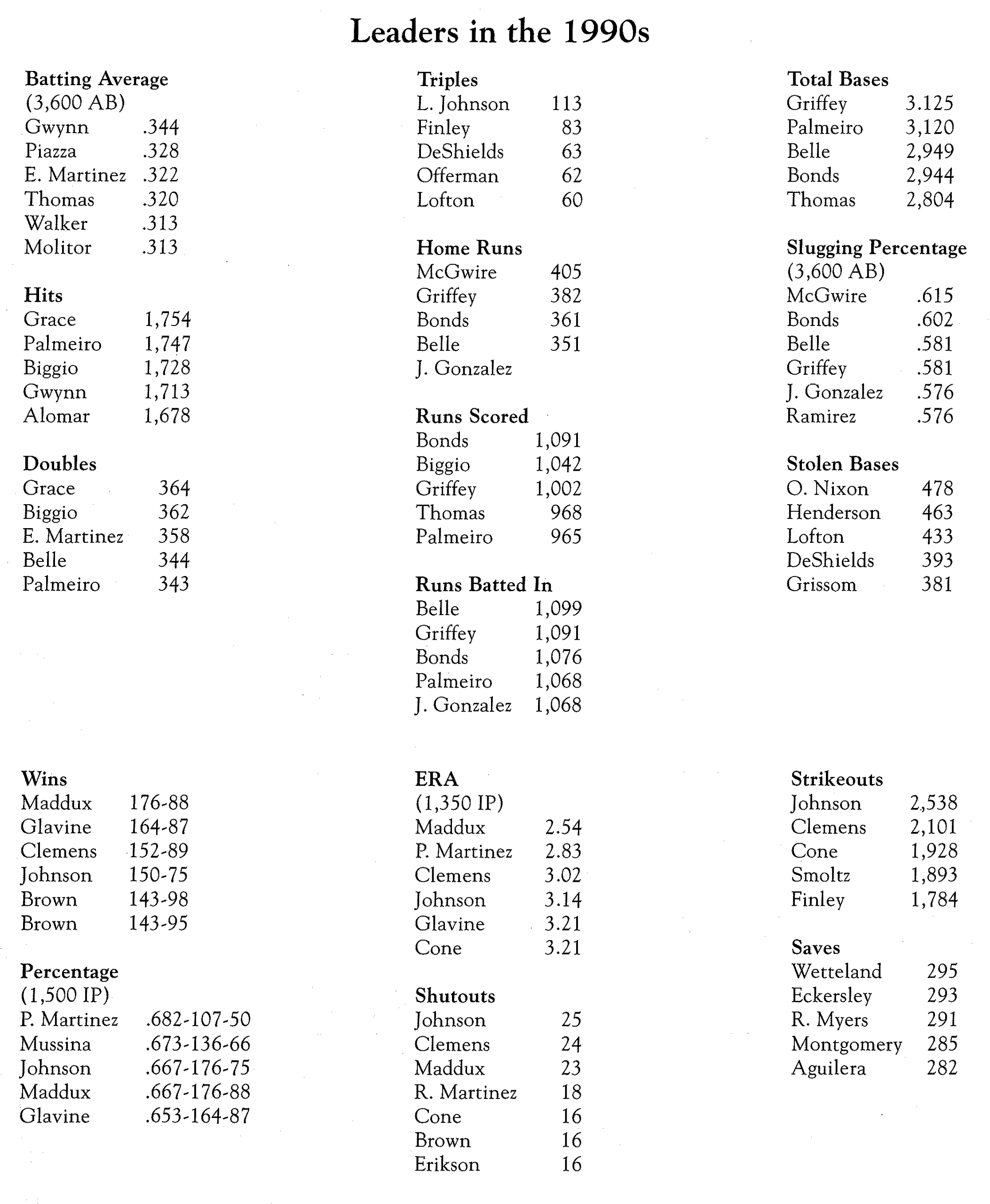Individual Records by Decades: Wagner, Cobb, Williams, Ruth Lead the Way
This article was written by Scott Nelson
This article was published in 2000 Baseball Research Journal
Forget about your rookie sensations, your flashes in the pan, your sophomore jinxes! Great careers? Not here, please. This is about decades. Now that we’ve completed ten of them in baseball’s modern era, it’s interesting to take a look at individual records for each ten-year period.
Individual greatness is all about performance over time, so some longevity is vital, but a couple of super seasons aren’t sufficient to make any of these lists. Likewise, a few mediocre summers shouldn’t necessarily kill a chance to be a decade leader. And even those with relatively short careers have a chance here to make an honor list.
Career leaders are often rewarded by simple longevity, but here a good ten-year run can put a guy among the elite. Bob Elliott, for instance, had just six 100-RBI seasons in his fifteen years in the big leagues. His best season was 1947 with 113, and he never led his league. But in the ’40s he topped the majors with 903 RBIs.
Guys like Elliott, Gus Suhr, and Ellis Kinder aren’t anywhere near the Hall of Fame, but for one shining decade in baseball history they were the best around in some category. So just who were these stars, the best over a full decade?
The degree to which Honus Wagner dominated the twentieth century’s first decade is seen in his top spot in no fewer than eight of ten batter categories. Same goes for Ty Cobb in the teens.
A fellow named Babe Ruth led in five categories in the ’20s, and in fact set all-time decade records in four of them. Jimmie Foxx in the ’30s, Ted Williams in the ’40s, Hank Aaron in the ’60s and Pete Rose in the ’70s were each leaders in four categories. Rogers Hornsby in the 1920s and Roberto Clemente in the ’60s were leaders in three.
Among pitchers, Walter Johnson in the teens, Hal Newhouser in the ’40s and Jim Palmer in the ’70s were “triple crown” winners.
Over all the years, though, only three performers were statistical leaders in more than one decade:
Williams, whose name appears six times over two decades despite missing about a third of the games while he was injured or in the military, was tops in batting and slugging averages in both the ’40s and ’50s. Stan Musial led in total bases in the ’40s and ’50s, to go along with two other appearances in the rundown. And Nolan Ryan led the majors in strikeouts in both the ’70s and ’80s. Twenty-two decade leaders on the list are not found in the Hall of Fame, led by Pete Rose, of course, who was banned for gambling infractions.
Other inactive notables who’ve been decade leaders but aren’t in the Hall include Willie Wilson, Dale Murphy, Maury Wills, Jack Morris, and John Tudor. Eddie Murray, the ’80s leader in RBIs, will soon be eligible for election.
Some who compiled top totals in a decade never led their league in a given year within the time frame. They include Mark Grace, still active, and Lou Boudreau in hits; Rose in total bases; Nellie Fox in triples; Tudor in ERA; Jeff Reardon in saves; and Bob Feller and Jim Palmer in winning percentage.
Sometimes ten also-ran performances will win the decade title.
Surprisingly, a quartet of major league career record holders never led the way for a decade in their specialty:
Hank Aaron, who owns one of the most notable marks, 755 home runs, hit 375 of them in the 1960s, but Harmon Killebrew slugged 393 in that period. Cy Young’s 511 pitching victories lead the all-time career list by nearly 100, but just 232 of them came in the 1900-1909 period when Christy Mathewson won four more. (Young won 265 games in the 1890s, not covered in this study.) Ed Walsh owns the career ERA record of 1.82, but his 1.68 mark for the century’s first ten years was second to Mordecai Brown’s 1.63. And though Lee Smith holds the career saves record of 478, he had just 239 of them in the ’90s, while John Wetteland posted 295. Smith had 358 saves in the ten years 1986-95, but that doesn’t count here.
Ruth’s remarkable roaring ’20s produced not only five decade titles but all-time decade records in four categories: home runs (467-that’s a 46.7 average for ten years!), runs scored (1,365), total bases (3,613), and slugging percentage (.740).
In addition, the ’20s saw Hornsby generate the best decade ever for hits (2,085) and doubles (405). In the teens Walter Johnson recorded the best decade in this century for wins (265) and ERA (1.60).
Other all-time records for a decade: Cobb’s amazing .387 batting average for the teens, Sam Crawford’s 167 triples for the first ten-year period, Foxx’s 1,403 RBIs in the ’30s, Rickey Henderson’s 838 stolen bases in the ’80s, Lefty Grove’s. 724 winning pct. in the ’30s, Ryan’s 2,678 strikeouts in the ’70s, and Wetteland’s 295 saves in the ’90s.
Interestingly, Hornsby is the only all-time decade record holder to spend all or most of his career in the National League. Ranking decade leaders in the fifteen stat lists points to the ’20s as tops, the ’30s as runner-up and the ’90s in third place. The ’40s through ’60s produced no all-time decade leaders.
Different season lengths appear to have had little effect on records over the decades. However, each team did play about fifty-three more games per decade in the ’20s through ’50s than in the first two decades. Seventy-two or so games per decade were added in the ’60s and ’70s, but strikes canceled about sixty games in each of the past two decades.
All these numbers, of course, reflect production over a specific ten-year period and ignore the claim that a decade runs, for instance, from 1991-2000. Any of the marks listed here might be exceeded within an indefinite ten-year window. But that’s another story.
Two batters and two pitchers made an especially heavy impact on cumulative baseball statistics of the 1990s. Mark McGwire in home runs and slugging, Mark Grace in hits and doubles, Greg Maddux in wins and ERA and Randy Johnson in shutouts and strikeouts were tops in the decade just past.
McGwire had the third best decade in history with 405 circuit clouts, despite missing 400 games because of injuries and player strikes. (He hit just nine homers in both 1993 and 1994.)
Grace never led the National League in hits in the 90s but compiled 1,754 in ten years. In doubles, he edged Craig Biggio by two, 364-362.
Maddux beat teammate Tom Glavine 176-164 for the ’90s victory title, and won the ERA crown (2.54) by a good margin over Pedro Martinez (2.83), who had the best win-loss percentage (.682) of the decade.
Johnson edged Roger Clemens in shutouts in shutouts, but had over 400 more strikeouts than runner-up Clemens.
Tony Gwynn, who batted .332 in the ’80s, second to Wade Boggs’ .352, easily led the ’90s with a .344 mark. Barry Bonds and Lance Johnson were likewise big winners in runs scored 0,091) and triples (13), respectively, while McGwire had 23 more homers than Ken Griffey.
Griffey led in total bases with just five more than Rafael Palmeiro, and Albert Belle beat out Griffey in RBIs, 1,099-1,091.
Johnson’s 2,538 strikeouts in the ’90s is second only to Nolan Ryan’s all-time decade mark of 2,678 in the ’70s. Fourth best decade marks are claimed by Bonds (runs scored), Belle (RBIs), Griffey (total bases) and Maddux (ERA).
While Rickey Henderson set the all-time decade mark of 838 stolen bases in the ’80s, he lost the ’90s crown to Otis Nixon, 478-463. John Wetteland set a new all-time decade record for saves with 295, just a pair more than Dennis Eckersley, who retired after the 1998 season.
Griffey, just thirty-one years old, and Martinez, twenty-nine, appear to have the best chance to make marks in this decade. Belle, Bonds, Grace, Johnson, McGwire, Maddux and Wetteland are all in their mid-thirties. Gwynn is forty.
Henderson, nearly forty-two, is a story by himself. Not only did he set the standard for stolen bases in a decade in the 1980s, but he scored 1,122 runs, the most since Lou Gehrig in the ’30s and the third highest ever. In the ’90s he scored 932 times, just 33 short of making the top five for the period.
In the ’90s rundown of the top five performers and ties, Bonds, Belle, Griffey and Palmeiro each appear in five of ten lists. Among starting pitchers, Johnson appears among the leaders in all five categories, Maddux and Clemens in four and Glavine in three.
SCOTT NELSON is a retired high school teacher in Mankato, Minnesota. He recently published a family history on his wife’s side and a 115-page history for his church’s 50th anniversary. But the best of times are those at the family cabin in Northern Minnesota.







